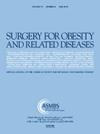针对阿片类药物处方的减肥手术:一个有效减少减肥手术后阿片类药物使用的国家模式。
IF 3.5
3区 医学
Q1 SURGERY
引用次数: 0
摘要
背景:处方阿片类药物在美国阿片类药物相关死亡中占很大比例。大约6%的opioid-naïve术后接受阿片类药物处方的患者成为慢性阿片类药物使用者。然而,减肥手术后慢性阿片类药物的使用可能是其两倍。目的:本研究旨在报告实施国家阿片类药物减少方案的可行性和有效性,并确定该方案对减肥手术后阿片类药物使用的影响。环境:代谢和减肥手术认证和质量改进计划(MBSAQIP)认可的医院。方法:靶向阿片类药物处方的减肥手术(BSTOP)是由MBSAQIP资助的国家项目。它分三个阶段执行:基线、试点和实施。共有271个mbsaqip认证中心实施了BSTOP协议,并报告了所有3个阶段的数据。分析方案依从性、住院阿片类药物使用、阿片类药物出院处方和门诊阿片类药物使用情况。还评估了医院一级的阿片类药物处方习惯。结果:9项工艺措施中6项的依从性明显改善(P < 0.001)。住院期间处方吗啡毫克当量(MMEs)的中位数从数据收集期间的35毫克当量下降到实施阶段的23毫克当量(dwassi - steel - critchlow - fligner, P < .001)。出院时阿片类药物处方减少9.5% (P < 0.001)。14.2%的医院实现了低住院MME处方,15.7%的医院成为低出院阿片类药物处方者。结论:在减肥手术中实施国家阿片类药物减少方案在减少阿片类药物处方和使用方面是可行和有效的。然而,出院后处方指南的采用率仍然很低。减少处方类阿片对过量死亡的影响的机会仍然存在。本文章由计算机程序翻译,如有差异,请以英文原文为准。
Bariatric surgery targeting opioid prescribing: a national model for effectively reducing opioid use after bariatric surgery
Background
Prescription opioids are responsible for a significant proportion of opioid-related deaths in the United States. Approximately 6% of opioid-naïve patients who receive opioid prescriptions after surgery become chronic opioid users. However, chronic opioid use after bariatric surgery may be twice as common.
Objectives
This study aimed to report the feasibility and efficacy of implementing a national opioid-reducing protocol and to determine the impact of this protocol on opioid use after bariatric surgery.
Setting
Metabolic and Bariatric Surgery Accreditation and Quality Improvement Program (MBSAQIP)-accredited hospitals.
Methods
Bariatric surgery targeting opioid prescription (BSTOP) was a national project sponsored by the MBSAQIP. It was executed in 3 phases: baseline, pilot, and implementation. A total of 271 MBSAQIP-accredited centers implemented the BSTOP protocol and reported data for all 3 phases. Protocol adherence, inpatient opioid use, opioids discharge prescribing, and outpatient opioid use were analyzed. Hospital-level opioid prescription habits were also assessed.
Results
Compliance with 6 of 9 process measures improved significantly (P < .001). Median morphine milligram equivalents (MMEs) prescribed during inpatient stay decreased from 35 MMEs during data collection to 23 MMEs during the implementation phase (Dwass-Steel-Critchlow-Fligner, P < .001). Opioids prescribed at discharge decreased by 9.5% (P < .001). Low inpatient MME prescriptions were achieved by 14.2% of hospitals, while 15.7% of hospitals became low-discharge opioid prescribers.
Conclusions
Implementation of a national opioid-reducing protocol in bariatric surgery is feasible and effective in reducing opioid prescribing and use. However, the adoption of postdischarge prescription guidelines remains low. Opportunities to reduce the impact of prescription opioids on overdose deaths persist.
求助全文
通过发布文献求助,成功后即可免费获取论文全文。
去求助
来源期刊
CiteScore
6.70
自引率
12.90%
发文量
570
审稿时长
56 days
期刊介绍:
Surgery for Obesity and Related Diseases (SOARD), The Official Journal of the American Society for Metabolic and Bariatric Surgery (ASMBS) and the Brazilian Society for Bariatric Surgery, is an international journal devoted to the publication of peer-reviewed manuscripts of the highest quality with objective data regarding techniques for the treatment of severe obesity. Articles document the effects of surgically induced weight loss on obesity physiological, psychiatric and social co-morbidities.

 求助内容:
求助内容: 应助结果提醒方式:
应助结果提醒方式:


